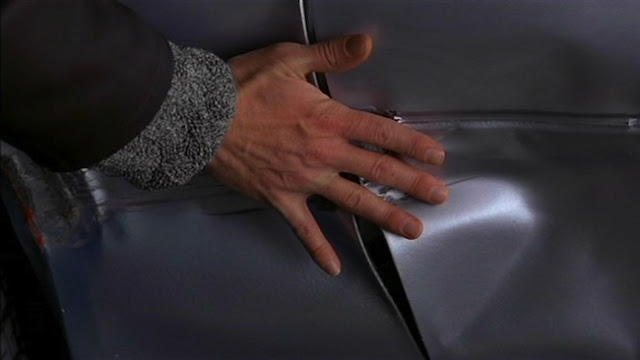Under pressure
SURELY SOME FRIEND WHO GREW UP IN CHICAGO and went to the Museum of Science and Industry as a kid wouldn’t resist: Wednesday night, wanna get drinks in a submarine?
But no one bites. After an action-packed ramble from the North Side and an extended trek through the building—is this the Mall of Science and Industry or what?—and a winding series of preliminary exhibits, you arrive at the massive, dry dock-like enclosure of the 35,000 square foot, $35 million construction and restoration of the U-505 Submarine that spent 50 long years out on the lawn.
Multimedia kiosks line the walls. Music booms. Forget if Kilroy was here, Jerry Bruckheimer’s influence certainly was—the music loops start to sound like promos for “CSI: North Atlantic.” Bill Kurtis’ voice booms up from one or more parts of the deep, “…the monotony could last for days or weeks.”
The exhibit opens in two days. Apparently, the work’s not done. One employee asks another, “Are you sleeping here?” The vast space smells like a two-car garage and the paint aisle at True Value. Security cameras dangle like depth charges from the ceiling, smoky globes on gray stalks.
Black-tie servers stand at attention at black-draped tables. White Longiflorum lilies—trumpet-shaped funeral flowers—stand sentry above longnecks of beer and bottles of wine. Behind glass, typical rations: a newly discovered tin of dough-in-a-can is near a table of chicken- and beef-on-a-stick. Simulated waves of light play over the blue-and-gray surface of the only surviving example of the 252-foot-tall, 700-ton “Type IX-C” submarine.
In the expanse, calming in its hugeness despite the clamor of the educational displays, a man’s voice brays, “An acre of yard! It was the first time I mowed it! Amazing!” His trio of pals nods. I feel woozy. The red of a small Nazi flag is the only patch of color in view.
I duck into the entrance of the sub, realizing a moment later I’ve got my beer with me. The world is smaller here. Older. Simulating a brand new Nazi killing machine, the small bunks have fresh gray wool blankets. A manual typewriter is branded “Erika” in lovely old script. Several voice trumpets are in the center of the ship, each labeled, one “sprechen küche”: Talk to the kitchen. A glass-front case is stacked with coral-red rimmed coffee cups. (There’s a display outside of the range of provisions that were carried on board.) The intimacy startles. Boys breathed, lived and died here. Handrails, freshly painted black, line the space. How could you shoot a movie in this claustrophobia? How would you fight a war? I grip the rail with my free hand. “Those were added,” an attendant nods, nods.
[Originally published in Newcity in a slightly different form, 9 June 2005.]
But no one bites. After an action-packed ramble from the North Side and an extended trek through the building—is this the Mall of Science and Industry or what?—and a winding series of preliminary exhibits, you arrive at the massive, dry dock-like enclosure of the 35,000 square foot, $35 million construction and restoration of the U-505 Submarine that spent 50 long years out on the lawn.
Multimedia kiosks line the walls. Music booms. Forget if Kilroy was here, Jerry Bruckheimer’s influence certainly was—the music loops start to sound like promos for “CSI: North Atlantic.” Bill Kurtis’ voice booms up from one or more parts of the deep, “…the monotony could last for days or weeks.”
The exhibit opens in two days. Apparently, the work’s not done. One employee asks another, “Are you sleeping here?” The vast space smells like a two-car garage and the paint aisle at True Value. Security cameras dangle like depth charges from the ceiling, smoky globes on gray stalks.
Black-tie servers stand at attention at black-draped tables. White Longiflorum lilies—trumpet-shaped funeral flowers—stand sentry above longnecks of beer and bottles of wine. Behind glass, typical rations: a newly discovered tin of dough-in-a-can is near a table of chicken- and beef-on-a-stick. Simulated waves of light play over the blue-and-gray surface of the only surviving example of the 252-foot-tall, 700-ton “Type IX-C” submarine.
In the expanse, calming in its hugeness despite the clamor of the educational displays, a man’s voice brays, “An acre of yard! It was the first time I mowed it! Amazing!” His trio of pals nods. I feel woozy. The red of a small Nazi flag is the only patch of color in view.
I duck into the entrance of the sub, realizing a moment later I’ve got my beer with me. The world is smaller here. Older. Simulating a brand new Nazi killing machine, the small bunks have fresh gray wool blankets. A manual typewriter is branded “Erika” in lovely old script. Several voice trumpets are in the center of the ship, each labeled, one “sprechen küche”: Talk to the kitchen. A glass-front case is stacked with coral-red rimmed coffee cups. (There’s a display outside of the range of provisions that were carried on board.) The intimacy startles. Boys breathed, lived and died here. Handrails, freshly painted black, line the space. How could you shoot a movie in this claustrophobia? How would you fight a war? I grip the rail with my free hand. “Those were added,” an attendant nods, nods.
[Originally published in Newcity in a slightly different form, 9 June 2005.]
